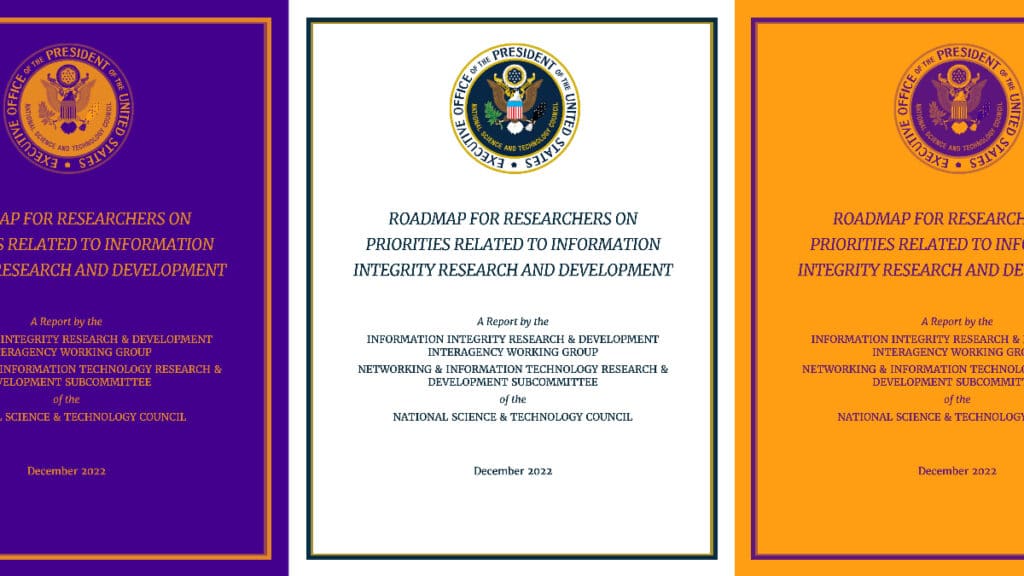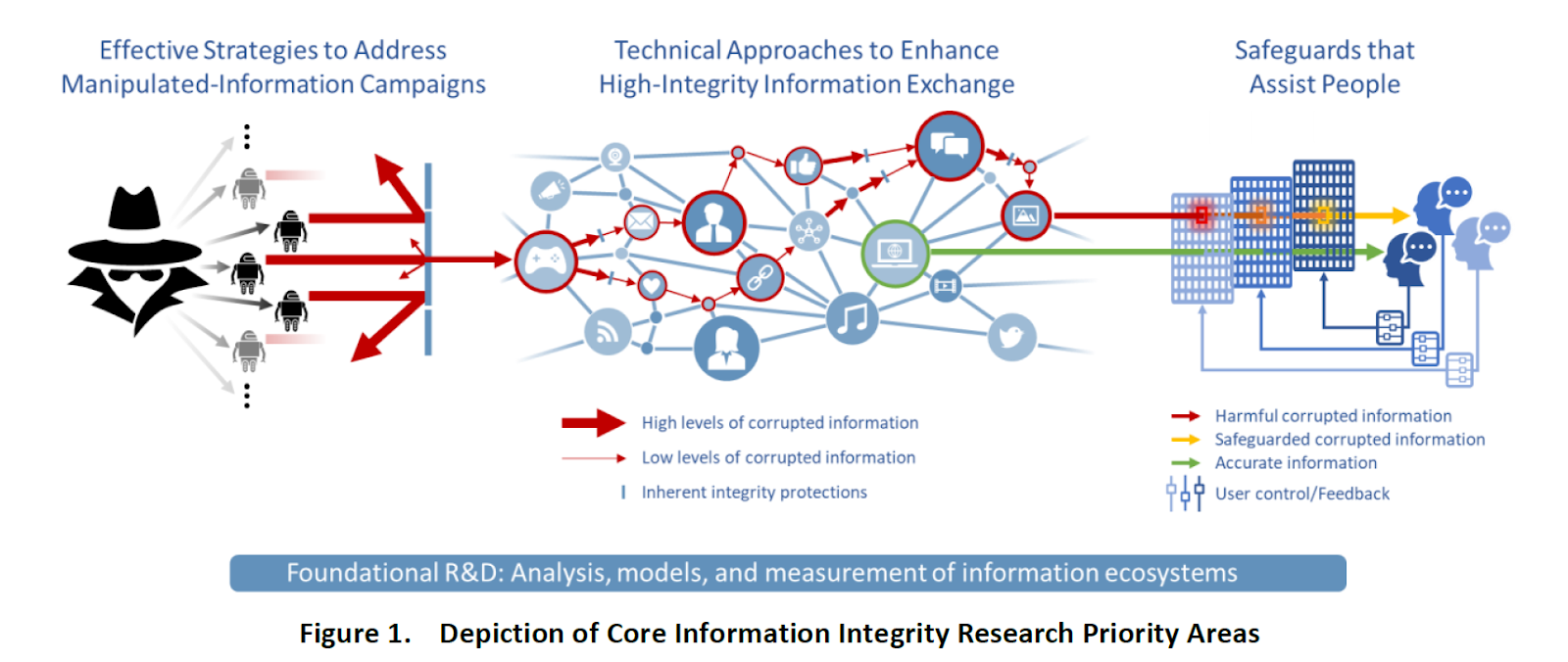Inside the White House Roadmap for Information Integrity Research
Tim Bernard / Jan 31, 2023Tim Bernard recently completed an MBA at Cornell Tech, focusing on tech policy and trust & safety issues. He previously led the content moderation team at Seeking Alpha, and worked in various capacities in the education sector.

On Friday, December 30, 2022—just before the holiday weekend one month ago—the White House published a document to its website titled “Roadmap for Researchers on Priorities Related to Information Integrity Research and Development.” The Roadmap is the product of an interagency working group under the aegis of the White House’s Office of Science and Technology Policy, and its purpose is to establish priorities for the U.S. federal government when funding external or internal research projects related to the field of “information integrity.” “Accurate and reliable information is central to the well-being of people and society,” states the document’s preface. “Manipulated information can cause harm across many social domains, including national security, local and national crisis response efforts, human rights and protections, and people’s individual health and safety.”
The working group, known as the Information Integrity Research and Development Interagency Working Group, and its Roadmap project were first announced in a White House briefing in December 2021, and a formal request for information was open on the federal register from March to May of 2022. Dozens of Federal agencies, universities, NGOs, and a handful of companies and individuals provided input.
In an environment where any government communication that even hints at the problems of mis- and disinformation is regarded as “censorship” by a substantial part of the electorate, the Roadmap also takes great pains to emphasize what it is not. It says it is not “a policy directive,” and it “does not make any recommendations regarding laws” or issue “any requirements or regulations.” Instead, the focus is purely on research:
The goal of this Roadmap is to share Federal Government research priorities in the area of information integrity, focusing on expanding access to high-integrity information while minimizing harm… its purpose is to stimulate research that can be used to strengthen the role of information ecosystems in the open exchange of ideas where healthy debate and free expression thrive.
That does not mean that the document declines to stake out any specific positions. Its clear bias is towards facts and the development of research-informed stances on these issues. It identifies specific gaps in the current body of knowledge on the subject of “information integrity,” including areas of weakness in past studies of the subject, and it highlights examples of good research. Perhaps unsurprisingly for a government report, it advocates for work that can inform policy-making and practice, though that is not to the exclusion of more theoretical research that provides a firm foundation for subsequent layers that should more directly support usable conclusions in the future.
Vision and Taxonomy of Harms
Using the rubric of “information integrity,” the Roadmap articulates a broader vision than the more common discourse around “fighting mis- and disinformation.”
An information ecosystem with high levels of information integrity is one in which people and organizations effectively communicate the best information available, in which threats to information integrity are proactively addressed, and in which individuals and populations are empowered by critical thinking skills to move toward high-integrity conclusions about the quality and intent of information they encounter.
Importantly, the report's positive framing for ideal information-sharing channels intrinsically opposes the highly censorious perspective that is so often imputed to advocates of impeding the flow of corrupted information. (“Corrupted information” is the Roadmap’s preferred term that encompasses mis- and disinformation, along with technically true while still misleading information.)
An open information ecosystem enables the free exchange of ideas and use of technologies. It supports a free exchange of ideas, enables ideas to flow from multiple sources, empowers people to express conflicting perspectives in a constructive manner, and leverages a free market of technologies to distribute information to audiences.
Though there is clearly a focus on social media in the Roadmap, the vision and research priorities it articulates can apply to all forms of media, rather than blaming all of the relevant problems on new technology and ignoring critical pieces of the puzzle that may lie in the domain of traditional media.
After laying out the vision, the Roadmap describes 17 categories of harm that can result from corrupted information. These are sorted into the larger categories of harms to:
- Consumers and Companies
- Individuals and Families
- National Security
- Society and Democratic Processes
This section alone can be a useful resource, and fuller descriptions of each of the subcategories along with references are found in Appendix C. The report then proceeds from the starting point of the vision and harms to define desired outcomes, goals, and then names four research priorities and two additional priorities relating to research operations that are the heart of the Roadmap:
Priority Areas

Research Priorities
- Analyze, Model, and Measure Information Ecosystems: This area represents foundational work on information systems to enable and better understand more narrowly-focussed work. At the most fundamental level, it requires developing theoretical models from different disciplinary perspectives. The “human dimension” must also be explored, that is, psychological and sociological analyses of how people form and spread beliefs and how they interact with different kinds of narratives and data. Also in this cluster is creating durable measurement methods for information integrity, information flows, and the impacts of corrupted information.
- Investigate Safeguards that Assist People: Studies focussing on counterspeech and educational interventions to increase the resilience of individuals and communities to corrupted information. Research should investigate current effectiveness of different approaches, with special attention to cultural and other aspects of context, as well as attempts to improve effectiveness and develop novel techniques.
- Envision Technical Approaches to Enhance High-Integrity Information Exchange: Interrogating mechanisms and causal links connecting information ecosystem design and positive and negative information integrity outcomes. This covers recommendation and amplification systems and other design affordances, including user customization, as well as policy dimensions and what it takes to rebuild trust in information sources.
- Understand Effective Strategies to Address Manipulated-Information Campaigns: Of particular interest to the government due to the potential safety and national security implications, this category includes work on anticipating and de-escalating coordinated campaigns, along with preemptive deterrence efforts. The Roadmap also highlights the need for developing real-time outcomes measurement to inform defensive efforts.
Operational Priorities
- Foster Data Access and Partnerships: A major obstacle to research in this area is accessing and processing suitable raw data. Partnerships between academics can develop tools and strategies for data analysis that can be used across multiple studies. Consortia of academics with any combination of other researchers, government agencies, NGOs and industry players should also share data while preserving privacy protections. One other notable support vector mentioned is for academics targeted for smearing due to their work on information integrity.
- Connect Research to Policy and Practice: Through study design, collaboration at all stages, and post-research pipelines, academic work should result in policy recommendations, policy-appropriate evidence, and policy evaluation. Similarly, practitioners, such as technologists, should be included in the process and be provided with prototypes and usable guidance.
The research priority areas are fully fleshed out in the Roadmap, each divided into multiple Research Objectives. From each Research Objective, a series of Research Actions is derived. These are the immediate outcomes from the specific projects of researchers in the field. Finally, a list of straightforward criteria is given for measuring progress in each Research Objective. The operational priorities are not subdivided into Research Objectives, but the structure is otherwise identical.
Finally, the Roadmap lays out responsibilities and concrete actions for a whole range of organizational stakeholders from government, academia, civil society, philanthropy, international partnerships and the private sector to support researchers in making progress in the Priority Areas.

Discreet, Yet Public
The Roadmap is fairly broad and inclusive; it seems likely that many if not most researchers in this field could identify how their own research focus fits into the priority areas. Though further progress on the gaps identified would certainly be welcome, rather than necessarily pushing researchers to study particular topics, this document allows them to situate their work within this map of the field as a whole and better understand and articulate how their research relates to that of others and to the outcomes that the Roadmap promotes. It also nudges them to consider how to improve their studies with an eye towards achieving the practical progress sought after here—for example, by sharpening their assessment of cultural context, or working with policy-makers to make their studies more helpful for crafting legislation.
However, this potential impact will depend on the broad dissemination of, minimally, the priorities to researchers and the full document within the relevant branches of the federal government. Although the primary purpose of the Roadmap is to provide guidance to federal agencies, it is explicit that the audience is also “researchers and educators, entrepreneurs and businesses, individuals and communities, nonprofits, and foreign partners.”
Thus far, the Roadmap has only appeared as links on two government websites and in a brief summary on the newsletter and blog of the Consortium of Social Science Associations, a public policy organization representing a number of academic associations and institutions. Although the comparison is not perfect, the Blueprint for an AI Bill of Rights, another recent output of the OSTP, was launched with its own website and received heavy media coverage despite having no immediate regulatory or policy impact, even on the federal government’s own practices. But the administration’s experience with the short-lived Disinformation Governance Board last year is a stark reminder that any government effort to address the problems of the information ecosystem—even if to simply study the matter—is potentially controversial, and could become a target of disinformation itself.
Authors
